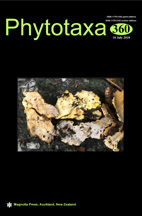Abstract
The taxonomic status of Ammopiptanthus kamelinii has been unresolved because of numerous characters that make it similar to another closely related species, A. nanus. In this study, we set out to resolve the complex relationships among A. kamelinii using samples from three populations, with a total of 38 individuals. Phenotypic indices (plant height, canopy, and leaf characters) and DNA data (ITS 1–4 nrDNA markers, as well as trnH-psbA, trnL-trnF, and trnS-trnG cpDNA markers) were used to understand the controversial taxonomic status of A. kamelinii. The phenotypic characters of A. kamelinii did not show a significant difference from A. nanus, and the nrDNA data did not reflect any variability from A. nanus, but all the individuals of A. kamelinii in Kyrgyzstan showed two new haplotypes in the cpDNA. When the genetic data were combined, specimens of A. kamelinii clustered together with A. nanus; therefore, we have confirmed that A. kamelinii cannot be recognized as a separate species of A. nanus and should be merged with the latter species. The description of A. nanus is revised here.

